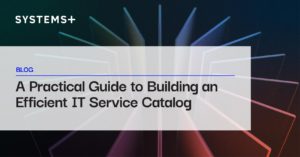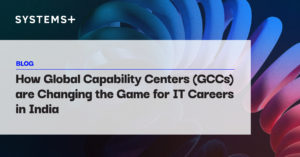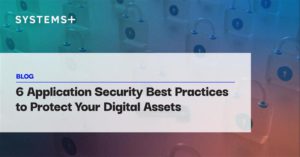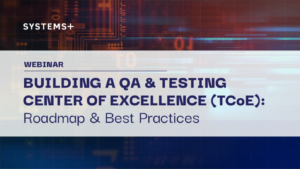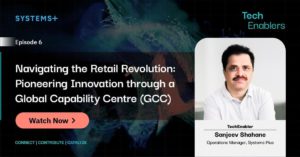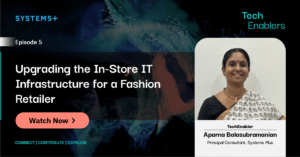Sapan: Welcome everyone to this edition of Enabling Digital with Systems Plus, a podcast series. Today we are joined by Ravi Shankavaram, a visionary thought leader specializing in business architecture and the strategic evolution of business models through intelligent technology integrations. With extensive experience spanning CPG, B2B and B2C markets, he brings deep expertise in AI and advanced analytics, next -gen infrastructure, and enterprise applications as a dedicated innovator. Ravi continuously experiments with technology and business transformation to uncover emerging opportunities and enable revolutionary approaches to organizational effectiveness. Ravi, it's great to have you here today.
Ravi: Pleasure to be here!
Sapan: Welcome. Let's jump right in. Speaking of evolution of business models, from your perspective, Ravi, when does it make sense for an organization to consider insourcing technology or digital capabilities globally, particularly in regions like India, rather than relying on partners or third parties?
Ravi: Yeah, the approach I took was to take a look at our competencies. What are we good at? Both from a region perspective and a headquarters perspective. And the idea was we wanted to do things well. So in areas we had the experience, we got our own teams to grow and expand. But in areas where we wanted to build the expertise at a global scale, we actually approached this insourcing model. And we approached it as early as 2014. And that's where we took a look at it from a few perspectives. One is, what is our capability maturity that we wanted to have in two, three years' time? What is the investment we wanted to make? And more importantly, what is the talent we wanted to build? And as we all know, it takes a little bit of time to incubate talent. And that's where we saw a great partnership with Systems Plus to build that.
Sapan: So then at New Balance, and even for that matter, other organizations that you've worked with, you seem to indicate it was a combination of things. It was a combination of speed, cost, control, innovation. All of these things played a role in the decision-making process. Is that a fair statement?
Ravi: I think you hit on all the key points there. One is, again, being an experimenter at heart is not just about technology. It's also about capability. So what we did was we definitely wanted speed and speed was only going to increase over a period of time. And we all know that to build talent and then to achieve some critical speed, it takes a bit of time. And innovation is closely tied to it because you want the right talent there. And of course, cost. And control is, we had a tagline after the pandemic, control your destiny. So this played right into that for us to keep building our expertise.
Sapan: Interesting. You mentioned you thought about this, you went down this journey starting in 2014. Obviously, that means you must have thought about it earlier. Most companies were not thinking this way. So what sort of triggered it within your organization to start thinking in this direction?
Ravi: In our case, we had built our own sort of talent expertise in certain competencies out of our India office with an eye towards supporting the globe and various time zones. We actually had some lessons learned from that. We also knew what we couldn't do by ourselves. So that's where we looked for a partner, and Systems Plus was a great partner in sort of helping us sort of incubate that idea, that approach, with the areas that we wanted to build the expertise on. And so... That's where we started, you know, with a small footprint. And then we, as we learned more about the model, the model is also... It's extremely important to remember that you have to make a commitment and you have to make sure, just like you're making a commitment to your staff, right? Your own in-house staff. This is no different than that. And then once you do that, you start seeing the results and then you also build on experience. So one competency, once you've got that under your belt, it becomes easier to go to the next set of competencies.
Sapan: No, fantastic. And you're right. It is a commitment. And I think those who miss that point usually end up in disaster. And we've seen that happen multiple times. Yeah, if you just approached it purely from a cost model, this is not good... In any relationship, if you just approached it purely from a cost model, that is not sustainable for the long run. I think you have to approach it with not just the cost. It is how are you building your capability? How are you building speed? And then as you're doing that, you know, you're also having a strategic control over your human capital and IP.
Sapan: Right. So what's your, I'm going to ask you sort of a two part question. I mean, today, India continues to be a go-to location for scaling internal tech teams, thanks to a compelling mix of cost efficiency and deep technical talent. But back then, what made you choose India? I mean, a lot of people are talking about Latin America, a lot of people are talking about Eastern Europe, etc. People still do, but what made you choose India?
Ravi: One important thing was we already had a practice, our own practice there, New Balance IT. So that helped us. But even if we did not have that, the reason we picked India was the time zone. We had teams that had to support, and even with the relationship with Systems Plus, we had teams that supported, that had eyes on the glass for Australia, New Zealand, and Japan, China, and all of that. And then even for Europe, that became easy. Now, it's at times a challenge for organizations in North America from a time zone perspective. But again, if you use the model intelligently in terms of the time zones that benefit you, I think India is a very, very good answer. That was one part. The second part is the level of talent that you have there. You know, the level of talent, the ecosystem with partners like Systems Plus, that really, I mean, they had the experience of working with companies in the US and across the globe. So it became a complementing thing for us to even learn from them on many aspects like hiring, retention, you know, what are the best practices and all of that. So that's where we found that India was a good model and we kind of used that model in other places as well.
Sapan: So I guess what works for you in aligning those distributed global teams, not only, as you've mentioned, you're supporting the Pacific, you're supporting Europe North America, of course, right, but how were you able to sort of align the core goals of the enterprise and how do you ensure that the teams actually move at the same pace and remain tightly connected to the business priorities and just then start doing things on their own or sort of go start going in different directions.
Ravi: So one thing was, you know, there was a need for us to provide more support on ERP and analytics and every now and then we needed help not only there, but in other areas. Our other big core systems are sourcing, PLM, international geographies with technologies like EDI and disparate technologies. So what we did was we actually had a portfolio of our applications and we said, where are we constantly needing more sort of burst capacity? And if we were to go to the CFO to say, hey, we need more headcount here, what do we do? And thankfully, my boss, the CFO and the CEO at that time said, hey, I want you to develop the practice out of India and build the competencies. And that's where we took the approach of, we don't have experience building a PLM practice in India. So we wanted to have our teams here manage that process, but Systems Plus became a great complement for us in terms of hiring, onboarding, making sure that the practice was done right. And really, it was a tremendous success. The other one was using burst capacity wherever we needed.
Sapan: Perfect. That's a good thing about it and makes a lot of sense. I want to fast forward to some of the trends that are happening today. As you are well aware, AI, data, those are all very prominent conversations going on today. And a lot of companies are looking to India to set up their AI COEs and their data COEs. So as you sort of guide companies coming to India, thinking of setting up their AI center of excellences, what would you sort of tell them to think about, in a sense, the watchouts? How do you even tell them to approach the AI thinking? Because, you know, it literally is a very different way of thinking. And the funniest thing is the talent pool is so new, so fresh. It requires some of us who've sort of been, even though we've been in IT for so many years, it requires a complete brainwash of forgetting everything that I've learned in the past and resetting my brain. So how have you balanced that? In your advisory work, especially lately, how are you advising your clients to think about AI, how to build the AI capability, and how to build that in India especially?
Ravi: So let me start with data analytics and AI and AI is, you know, is definitely for real. There's been a little bit of hype, but it is a technology that is going to be here for a very long time. So if you took that sort of longer term view, I think, you know, so you've honed in on the domain. People are going to look for talent everywhere. So my first thing is, don't just get fixated on a particular geography to look at talent. You know, if you're in North America, don't just say, I'll build the practice only here. So you almost need to have a multi-pronged approach. And I would like to use the term build while you buy, you know, is this great insourcing model. So you start building your talent even in other geographies. India definitely has a lot of talent. And so you sort of build it in a dual fashion. Now, the advantages you also have, some degree of cost competitiveness, but that shouldn't be the only factor. So when you take that approach, then what happens is you are now going with a multi-pronged approach. You're building the expertise, you're building talent, you're also building, incubating that knowledge in the organization. So it's not for this iteration, right? With AI, it's always what is going to happen with the next iteration. And sometimes that is the game changer. And so that's where I would say, and to some degree, it is not just AI. You can use this approach for anything. You can use it for cybersecurity, you can use it for infrastructure, you can even use it for enterprise applications because that's where your key domain people and technical experts come into play to architect the next set of solutions. So if used well, this is definitely a very good competitive model.
Sapan: I guess looking at your experience, one of the major upsides of insourcing is the ability to shape the capability and the culture from within. So sort of what approaches have you used, have worked for you to attract not only the top talent, right, but also build a culture that sort of has been so strong through and through at New Balance. I know we have that, and I know you're very big on culture. We've had these conversations many times. So what has enabled you sort of to build that? And especially today, when you're thinking of building something, you know, sort of a capability within AI, when everything's just so new, how do you sort of get that alignment and thinking in place?
Ravi: That is a great point, Sapan. I mean, culture is something foundational, right? And it is sustaining for a long time. It also takes time to build. So we as a company at New Balance, when I was there, and even my past experience, that is almost like a key attribute for a company to do well. So the approach we took was we built our own practice. So we use some lessons learned from there. Even in the insourcing model, we never made a distinction between, hey, these guys are from Systems Plus. These guys are from New Balance. We never made that distinction. So there's a little bit of onboarding that needs to happen with your leadership. That's extremely important. And you cannot cut corners on that. You cannot look at it as a transactional relationship. You have to look at it as a partnership that you're going to grow, right? And I give this advice even for contracting projects, you know, consulting projects. Because only then you get the best outcomes or the outcomes that you had thought that you had desired. So that's one part. The second one is the engagement of the people. Given that they are long -distance, you have to make an extra effort to make sure that there is an inclusion there. And it is not just India. We saw this even with our European office. We saw this in our Asia-Pac office. All of that. Or Japan and China and all of them, right? You have to also empower them to make certain decisions. And then there's a feeling of ownership there from the individuals. And then the outcome is, for the most part, all good. So I would say that is extremely important. There needs to be an understanding at two levels. One is at the managerial level or the leadership level. And the second is at the execution level where folks are the experts who are brought in, they need to be onboarded properly. The advantage with the insourcing model is companies like Systems Plus do a very good job of setting the expectations because they also learn what the new balance principles of onboarding were and so it became easier for them to also understand the expectations and also be a part of it.
Sapan: Ravi, I definitely appreciate the credit but I think a lot more credit goes to you and sort of the way you disseminate it and sort of work with your leadership team to make sure everybody who came into the model thought themselves as New Balance and with that you got the ownership, right? I mean these guys were all ready to work anytime in the middle of the night, wake them up. We are going to make sure New Balance succeeds. And that was the thinking. And I think that has a lot to do with sort of what you inculcated. So I definitely want to thank you for that, through that process. Thank you so much.
I want to switch a little bit, right? And sort of ask you, the word insourcing has evolved to GCC, Global Capability Centers, and they truly have become Global Capability Centers for most companies, right? Do you see a limit though? Do you see a limit to what a Global Capability Center can do versus what needs to be done in headquarters? We always sort of tell our clients, let the strategy be sitting at the headquarters, but I've noticed that has been changing. What are your views on that?
Ravi: It's an excellent question. And just the fact the term Global Capability Center means a lot. It cannot be just only from one area. It's a very hard stride to follow. But companies who do this well have great success. You know, we've seen, for example, from many companies. Talent sits everywhere. Now, sometimes some core decisioning has to be done from a central point and usually that happens to be the headquarters. But again, the headquarters also cannot make a decision in a vacuum. They need the inputs from key areas. I would say going forward, and my earlier point was, if you have a great analytics person, whether it be in region or in the global, I mean, essentially all of them are a part of the global capability center. That's how you're trying to distribute the talent across the globe. I think that model in a distributed or in some sort of a federated model is the model of the future. It cannot be just in one place. Now, the challenges are time zones, decisioning and all of that. And I think some of them can be complemented by bringing people together. You know, like what COVID has taught us is we can work remotely and independently, but we can also come together, right? And maybe that cadence has to be established and it's different for every company. But if you did that in a very, very disciplined fashion, I think it would pay you rich dividends over time.
Sapan: So then, I want to take some of your wisdom. So what do you feel that organizations typically underestimate when embarking on setting up GCCs? What missteps have you seen and what do you feel can and should be avoided?
Ravi: I think a couple of things or maybe more than a couple of things come to my mind. One is purely looking at it from a cost perspective. You cannot look at this as a cost. Definitely cost is an important attribute there. You have to have it as a competitive model because you want to sustain for a period of time, right? Second thing is that is underestimated is, we let somebody else manage this and it's not our, you know, if it works great, then it is us. If it's not, then it's somebody else. That cannot happen. It's like a shared responsibility and one has to invest the time just like you would invest the time in your local office, right? Even in your local office, if you did not spend the time, you don't get a good output. The third thing is making sure that you have your team be ready and take the right approach. Treat the team that is a part of the Global Capability Center as yours, even if they are not sitting here. Now, some of that has happened because folks are experienced post COVID because you have people even here working in different states or different regions, actually. And that experience is somewhat elevated now. So organizations need to make sure that that is closely watched and monitored. So I see a lot of companies sort of balk at the issue of the time it takes to set these GCCs up, right? Fundamentally, because either they're used to the traditional model, right? But having said that, as you rightly said, it's an investment, it's an investment from all sides right so you know how do you balance the pressure to deliver quick outcomes with long-term investment that is actually required to build a strong in-house capability , I mean especially in critical areas such as data platform, cybersecurity, digital supply chain and even AI for that matter today so I think there are a few ways to make sure that this doesn't become a three year long exercise to see the result. I would use a combination of first identify what is an area that you see that you can get immediate help and some wins. So you build on the shorter term wins. You amplify those wins because when you start amplifying those wins, others will want to adopt. That's what we did at New Balance. Sapan saw that Ravi had success with a model and then Sapan said, I want to do the same thing. So it garners a little bit of acceptance. They're willing to put in, they're willing to learn from the peers. That is another very, very important thing that groups need to do that. So don't start with a big bang. Start maybe somewhat small to medium and start elevating the wins.
Sapan: Okay. So that's some great advice. But I do want to get your perspective on in the end, you are a leader. You have a seat at the table. You need to show results. You need to demonstrate that this is working, etc. Whatever the case may be. So it's a lot of pressure for for any CXO because you're taking a significant decision and these are not decisions that are very easy to sort of take back. I understand our model enables a little bit of the ability to take chances more than maybe just going all in on your own. But having said that, what advice would you give to technology leaders who are sort of hesitant to move towards this global insourcing sort of model because of perceived complexity or you know just the internal resistance that you that you sort of see people think that the jobs are going away etc how would you navigate that how do you manage that? I know you touched on start small sort of learn fast and then sort of de-risk yourself but there's got to be something at the leadership level that you got to sort of you know have very clear in those leaders' heads saying that, guys, this can work if you do these things. So what are your thoughts on that?
Ravi: Great, great point. Again, I'll echo the point. This is a model that you're developing with an idea of build while you buy. That is one part. You're going to build capabilities, right? Every year you're going to say, I need capabilities here. I need to add capabilities here. And you're doing that with the C -level leaders, the executive leadership team. And it's important. And sometimes they are your best champions to say, hey, no, we know Ravi's organization needs this because it's going to help us. Now, if you bring those leaders into the mix, to support you and you also say that, hey, we'll do it responsibly with a cost model that is somewhat responsible and at the same time, it's going to build our expertise. I think that's a great place to start. The second thing is also demonstrating to the leaders that with the team we have today in a certain region, we can deliver X. But we can deliver X plus something for you. And in some cases, we can even deliver a new capability that we never had. And this is how we're going to do that. So that's an important thing to engage your sort of leadership team. It's not just a CFO. It's not just a CEO. It's your fellow peers in various domains. That's the first thing. The second thing is, again I would echo the point of since you're doing the build while you buy, you know, you're being very deliberate in the way how you're building your capabilities. So you need to make sure that you are learning enough from it. Think of it as a learning exercise more than a delivery exercise. And that's where you want to make sure you have the right people on your team. It's almost like you're being an entrepreneur here. And you're building that capability with a partner and a trusted partner.
Sapan: Fantastic. Ravi, we'll switch gears completely. Final question of the evening. So, in the advisory work that you are now embarking on, what are some of the most common questions they're getting around building data analytics AI etc or if there's something else that you're getting a lot of ,you know, alternative sourcing models, I'm sure you're getting them all and people are really want to pick your brains but so if you can enlighten us on some of the hot topics of the day these days that you're seeing.
Ravi: It's interesting, we are at a crossroad of so many things all coming together, right? So I'll start with my passion has always been enterprise technologies at enterprise scale. At times we've, you know, maybe in the last 20 plus years, we've talked about speed, we've talked about methodologies, but really, you know, that was almost geared towards only tech. You know, we never measure the speed of decisioning, the speed of adoption in the line of business. So now leaders are asking me, how do we do that? Second thing is the importance of data. You know, if you understand, and I break it into two parts. One is the interface applications, I call it, and they can be the enterprise applications. And I call them, this is my own term that I coined called domains of truth. And if you start honing in on that, then you start capturing data. And then data with advanced analytics and AI starts giving you patterns that you were not able to see. Or it took a long time for you to see because you had to spend so much time in assembling all the information and now AI is that's the game changer about AI and so and again I would caution companies not to get bogged down by very large, you know, initiatives, break it into smaller chunks. And I call them digital dots. If you start building these digital dots, then you have a better shot at connecting the dots to a picture. And that's what is going to inform you. So this is my message to organizations and almost break down the one is the orange. You know, done a better job at breaking down the silos. But my message to CEOs and board members are, you know, break down the sort of monolithic way of thinking. And so, even with talent, break down the monolithic way of saying we'll just do it all in one area or we've got competency in a certain area or certain, you know, distribute that. In a way that is going to make sense. And then there's going to be a war for talent. You know, even with AI, it's the same thing as we saw in the dot-com days. You know, the technologies from the dot-com have not slowed down. You know, we're doing more. And so we will be doing more. Now, the nature of the work is going to change. But the need is still going to be there.
Sapan: No, I absolutely agree. Ravi, thank you. Thank you so much for joining us today. I encourage all our listeners to reach out to Ravi through his LinkedIn, etc. He's got a wealth of knowledge and one of the nicest guys you'll ever meet, to be perfectly honest. So I really do encourage all of you to reach out to Ravi and pick his brain, if nothing else. But Ravi, thanks once again. I really appreciate it. And we look forward to seeing each other more often and if not, I'll see you in the US next time I'm there. Thanks all for joining and looking forward to the next episode of Enabling Digital with Systems Plus.
Ravi: Thank you, Sapan and thank you Systems Plus. My pleasure. Thank you.


